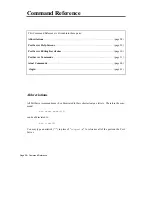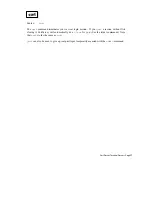
Page 26
Ÿ
Quick Start
Telnet and modems
In a previous part of this getting-started example, we installed a modem on Port #4, with DTR
(“hardware”) handshaking and configured for bidirectional (incoming and outgoing calls) use.
Here, Betty will telnet to that modem (from her Port #2 terminal to the modem on Port #4), use
“AT” type modem commands to set a fixed DTE interface and 2400 baud, then call an
information service.
The PortServer cannot switch the serial line baud rate depending on the kind of
connection made, so you should configure the modem to lock the serial line
speed at the highest baud rate the modem will go. (See your modem’s documen-
tation.)
The telnet command is used to log into a remote system using the telnet protocol. (In this case,
calling from the PortServer Port #2 to Port #4, the PortServer itself is a “remote system!") Recall
that the telnet syntax is
telnet
hostname|hostip [tcp port#]. The hostname here is actually the
PortServer’s nodename that you configured when you first set up the PortServer—see page 10.
(In this example, the PortServer’s nodename was set to be termserver.) The tcp port# parameter
comes into play when telnetting to devices on the PortServer.
However, it is not possible to telnet to Port #4 by entering “
telnet
termserver
4
”. By Digi
International convention, we add 2000 to the PortServer’s port number to create the tcp port
numbers. To reference the modem on port 4, use the value 2004.
See PortServer Port Numbers on page 101 for more detail.
Telnet to
Modem on
Port #4
Betty logs into her terminal on Port #2, then connects to the
modem installed on Port #4 with the telnet command:
telnet termserver 2004
Betty is now connected directly to the modem, and can directly
enter commands to the modem (like “AT” commands to Hayes
or Hayes-compatible modems). This example assumes Betty has
a 2400 baud Hayes-compatible modem attached to Port #4.






























